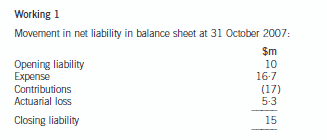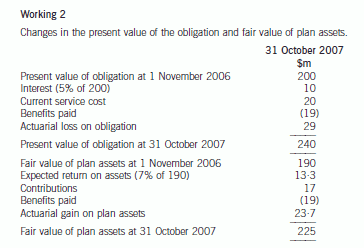本文为你详细介绍!关于大学生报考ACCA都有哪些好处~
发布时间:2020-02-20
ACCA让来自不同背景的有志之士都有机会进入财会行业,尤其是在校大学生们,他们可以通过ACCA实现转专业或转行。但报考ACCA都有哪些好处呢?赶紧来看看以下这些内容吧。
★全面完善的课程体系
ACCA的课程使学员全面掌握财务、财务管理、审计、税务及经营战略等方面的专业知识,提升分析能力并拓宽战略思维。
★理论与实际的密切结合
ACCA的专业资格是理论知识与实际经验的高度紧密结合。新考试大纲充分表达了雇主和专业人士的意见,反映了现代商务社会对财会人员的要求。
★对专业价值和职业操守的重点强调
ACCA创举性地开设了在线职业操守训练课程,它给予学员一系列的职业操守的理念,并设置了多个自我测试题,检验学员职业操守的价值观和行为。取得ACCA会员资格要完成三个“E”,即通过考试、完成在线职业操守训练课程、并取得三年相关工作经验。
★国际标准与本地实情的和谐统一
ACCA考试大纲以国际会计准则/国际财务报告准则和国际审计准则作为依据设计考试内容,并提供了包括中国在内的40多种不同国家和地区的法律与税务方面的试卷,这使得ACCA成为最切合中国实际的国际性会计师资格。
★公平一致的考试标准
ACCA的专业资格考试采用全球统一标准,即统一教材、统一考试、统一评卷,最后会员取得全球统一的证书。
★遍布全球的考点网络
学员在一个国家向ACCA注册后,可根据需要在全球350多个考点中选择、更换适合自己的考试中心。
★认证与学位的相互补充
ACCA在全球范围内寻求与优秀院校的广泛合作。满足一定的条件后,ACCA学员将有机会获得英国牛津-布鲁克斯大学应用会计理学士学位。
由上述内容我们可以得出结论,学习ACCA的优势有很多,而大学生选择ACCA是一个很不错的决定,所以同学们快行动吧!另外,如想了解更多关于ACCA的资讯,敬请关注51题库考试学习网!
下面小编为大家准备了 ACCA考试 的相关考题,供大家学习参考。
(b) (i) Discusses the principles involved in accounting for claims made under the above warranty provision.
(6 marks)
(ii) Shows the accounting treatment for the above warranty provision under IAS37 ‘Provisions, Contingent
Liabilities and Contingent Assets’ for the year ended 31 October 2007. (3 marks)
Appropriateness of the format and presentation of the report and communication of advice. (2 marks)
(b) Provisions – IAS37
An entity must recognise a provision under IAS37 if, and only if:
(a) a present obligation (legal or constructive) has arisen as a result of a past event (the obligating event)
(b) it is probable (‘more likely than not’), that an outflow of resources embodying economic benefits will be required to settle
the obligation
(c) the amount can be estimated reliably
An obligating event is an event that creates a legal or constructive obligation and, therefore, results in an enterprise having
no realistic alternative but to settle the obligation. A constructive obligation arises if past practice creates a valid expectation
on the part of a third party. If it is more likely than not that no present obligation exists, the enterprise should disclose a
contingent liability, unless the possibility of an outflow of resources is remote.
The amount recognised as a provision should be the best estimate of the expenditure required to settle the present obligation
at the balance sheet date, that is, the amount that an enterprise would rationally pay to settle the obligation at the balance
sheet date or to transfer it to a third party. This means provisions for large populations of events such as warranties, are
measured at a probability weighted expected value. In reaching its best estimate, the entity should take into account the risks
and uncertainties that surround the underlying events.
Expected cash outflows should be discounted to their present values, where the effect of the time value of money is material
using a risk adjusted rate (it should not reflect risks for which future cash flows have been adjusted). If some or all of the
expenditure required to settle a provision is expected to be reimbursed by another party, the reimbursement should be
recognised as a separate asset when, and only when, it is virtually certain that reimbursement will be received if the entity
settles the obligation. The amount recognised should not exceed the amount of the provision. In measuring a provision future
events should be considered. The provision for the warranty claim will be determined by using the expected value method.
The past event which causes the obligation is the initial sale of the product with the warranty given at that time. It would be
appropriate for the company to make a provision for the Year 1 warranty of $280,000 and Year 2 warranty of $350,000,
which represents the best estimate of the obligation (see Appendix 2). Only if the insurance company have validated the
counter claim will Macaljoy be able to recognise the asset and income. Recovery has to be virtually certain. If it is virtually
certain, then Macaljoy may be able to recognise the asset. Generally contingent assets are never recognised, but disclosed
where an inflow of economic benefits is probable.
The company could discount the provision if it was considered that the time value of money was material. The majority of
provisions will reverse in the short term (within two years) and, therefore, the effects of discounting are likely to be immaterial.
In this case, using the risk adjusted rate (IAS37), the provision would be reduced to $269,000 in Year 1 and $323,000 in
Year 2. The company will have to determine whether this is material.
Appendix 1
The accounting for the defined benefit plan is as follows:



Assume that the rates and allowances for 2004/05 apply throughout this part.
(b) Explain the consequences of filing the VAT returns late and advise Fred how he should deal with the
underpayment and bad debt for VAT purposes. Your explanation should be supported by relevant
calculations. (10 marks)
(b) Late filing of VAT returns
The late filing of two or more VAT returns within the period of one year will give rise to a default surcharge. This occurs when
either
– The return is late and/or
– The payment is late.
Customs & Excise will serve a surcharge liability notice on the taxpayer when a single return is filed late and/or the VAT due
is paid late. The surcharge period will run from the date of notice to the anniversary of the quarter end of the period in which
the trader is in default.
Any further defaults within the surcharge period will extend the surcharge period.
If there is a late payment of VAT in the surcharge period, a surcharge will be levied at the rate of 2% on the first occasion,
rising progressively to a maximum of 15% if there are several defaults. One complete year of correct compliance is necessary
to escape the default surcharge regime.
For Flop Ltd, the surcharge period originally ran to 31 December 2005 but was extended to 31 March 2006 as the second
return is late. This could be extended again if the June return is late. The second default (31 March return) will give rise to
a 2% surcharge, based on the tax paid late of £24,000. This gives a surcharge of £480. This exceeds the de minimus level
of £400, so will be collected.
To avoid a further surcharge, the VAT return to 30 June 2005 should be submitted by 31 July at the latest. This would save
5% x £8,250 = £412.
In addition, Flop Ltd should obtain a refund of the VAT on the bad debt. Relief is available where;
(i) the debt is more than six months old, and
(ii) the debt has been written off in the creditor’s accounts.
The claim must be made within three years. The amount of VAT repayable is 17·5% of £50,000 = £8,750. If this is claimed
though the VAT return to 30 June 2005, there should be a net VAT repayment of (£8,250 - £8,750) = £500. Even if this
return is submitted late, the fact that no VAT is outstanding means that there will be no surcharge actually payable (as
calculated above), but the surcharge period will nevertheless be extended.
14 Alpha buys goods from Beta. At 30 June 2005 Beta’s account in Alpha’s records showed $5,700 owing to Beta.
Beta submitted a statement to Alpha as at the same date showing a balance due of $5,200.
Which of the following could account fully for the difference?
A Alpha has sent a cheque to Beta for $500 which has not yet been received by Beta.
B The credit side of Beta’s account in Alpha’s records has been undercast by $500.
C An invoice for $250 from Beta has been treated in Alpha’s records as if it had been a credit note.
D Beta has issued a credit note for $500 to Alpha which Alpha has not yet received.
声明:本文内容由互联网用户自发贡献自行上传,本网站不拥有所有权,未作人工编辑处理,也不承担相关法律责任。如果您发现有涉嫌版权的内容,欢迎发送邮件至:contact@51tk.com 进行举报,并提供相关证据,工作人员会在5个工作日内联系你,一经查实,本站将立刻删除涉嫌侵权内容。
- 2020-01-10
- 2020-01-10
- 2020-04-24
- 2020-01-10
- 2019-12-28
- 2020-04-30
- 2020-01-10
- 2020-05-09
- 2020-01-10
- 2020-05-09
- 2020-01-09
- 2020-04-23
- 2020-01-10
- 2019-07-20
- 2021-07-31
- 2020-02-02
- 2020-01-03
- 2020-04-18
- 2021-04-24
- 2020-04-28
- 2020-01-10
- 2021-09-13
- 2020-01-10
- 2020-01-10
- 2020-01-11
- 2020-01-10
- 2020-01-09
- 2020-05-15
- 2020-01-10
- 2020-04-09